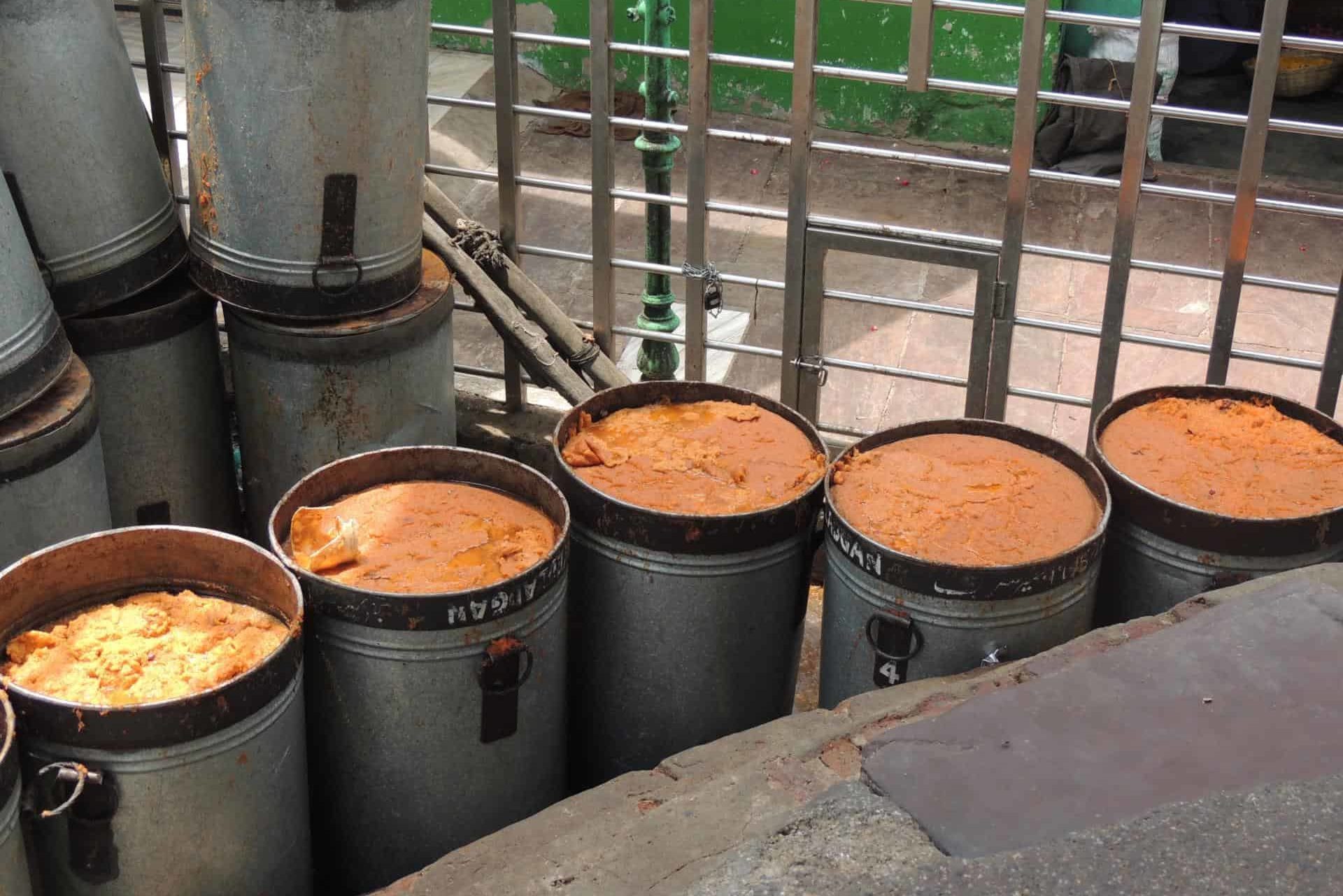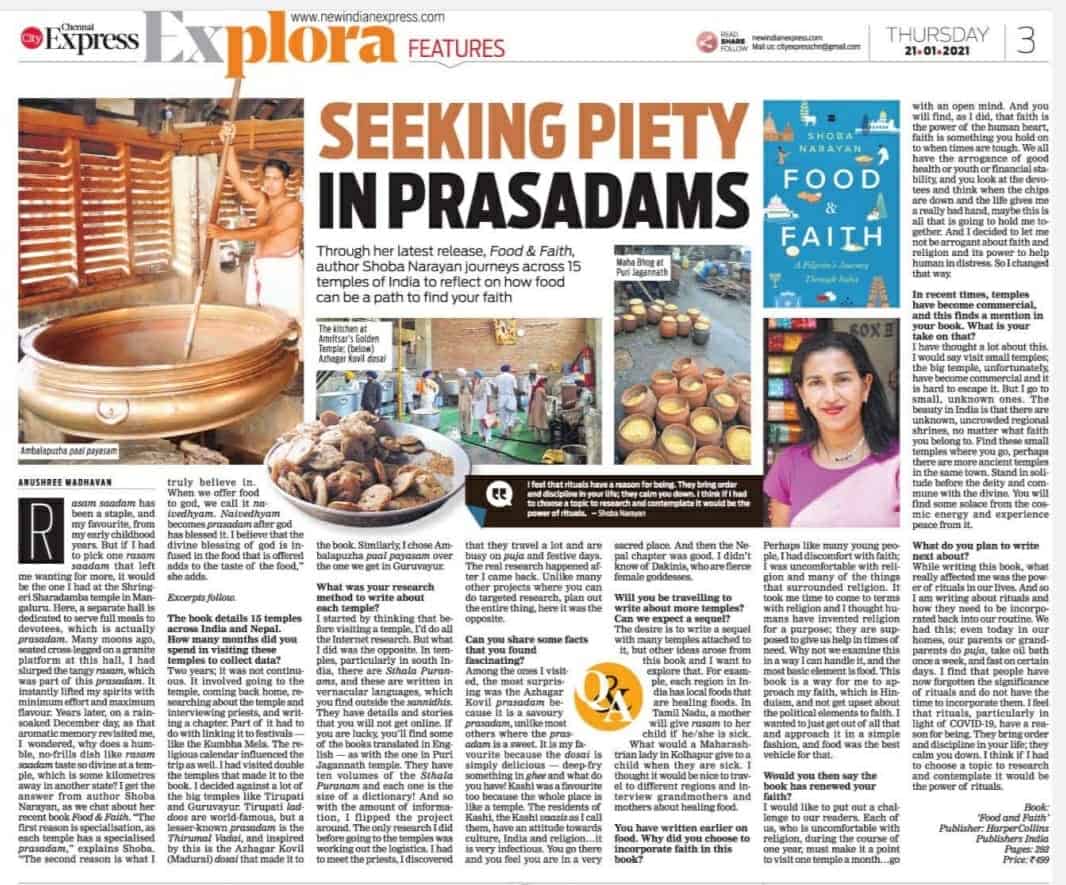CHENNAI: Rasam saadam has been a staple, and my favourite, from my early childhood years. But if I had to pick one rasam saadam that left me wanting for more, it would be the one I had at the Shringeri Sharadamba temple in Mangaluru. Here, a separate hall is dedicated to serve full meals to devotees, which is actually prasadam.
Many moons ago, seated cross-legged on a granite platform at this hall, I had slurped the tangy rasam, which was part of this prasadam. It instantly lifted my spirits with minimum effort and maximum flavour. Years later, on a rain-soaked December day, as that aromatic memory revisited me, I wondered, why does a humble, no-frills dish like rasam saadam taste so divine at a temple, which is some kilometres away in another state?
I get the answer from author Shoba Narayan, as we chat about her recent book Food & Faith. “The first reason is specialisation, as each temple has a specialised prasadam,” explains Shoba. “The second reason is what I truly believe in. When we offer food to god, we call it naivedhyam. Naivedhyam becomes prasadam after god has blessed it. I believe that the divine blessing of god is infused in the food that is offered adds to the taste of the food,” she adds.
Excerpts follow.
The book details 15 temples across India and Nepal. How many months did you spend in visiting these temples to collect data?
Two years; it was not continuous. It involved going to the temple, coming back home, researching about the temple and interviewing priests, and writing a chapter. Part of it had to do with linking it to festivals — like the Kumbha Mela. The religious calendar influenced the trip as well. I had visited double the temples that made it to the book. I decided against a lot of the big temples like Tirupati and Guruvayur. Tirupati laddoos are world-famous, but a lesser-known prasadam is the Thirumal Vadai, and inspired by this is the Azhagar Kovil (Madurai) dosai that made it to the book. Similarly, I chose Ambalapuzha paal payasam over the one we get in Guruvayur.
What was your research method to write about each temple?
I started by thinking that before visiting a temple, I’d do all the Internet research. But what I did was the opposite. In temples, particularly in south India, there are Sthala Puranams, and these are written in vernacular languages, which you find outside the sannidhis. They have details and stories that you will not get online. If you are lucky, you’ll find some of the books translated in English — as with the one in Puri Jagannath temple. They have ten volumes of the Sthala Puranam and each one is the size of a dictionary! And so with the amount of information, I flipped the project around. The only research I did before going to the temples was working out the logistics. I had to meet the priests, I discovered that they travel a lot and are busy on puja and festive days. The real research happened after I came back. Unlike many other projects where you can do targeted research, plan out the entire thing, here it was the opposite.
Can you share some facts that you found fascinating?
Among the ones I visited, the most surprising was the Azhagar Kovil prasadam because it is a savoury prasadam, unlike most others where the prasadam is a sweet. It is my favourite because the dosai is simply delicious — deep-fry something in ghee and what do you have! Kashi was a favourite too because the whole place is like a temple. The residents of Kashi, the Kashi vaasis as I call them, have an attitude towards culture, India and religion…it is very infectious. You go there and you feel you are in a very sacred place. And then the Nepal chapter was good. I didn’t know of Dakinis, who are fierce female goddesses.
Will you be travelling to write about more temples? Can we expect a sequel?
The desire is to write a sequel with many temples attached to it, but other ideas arose from this book and I want to explore that. For example, each region in India has local foods that are healing foods. In Tamil Nadu, a mother will give rasam to her child if he/she is sick. What would a Maharashtrian lady in Kolhapur give to a child when they are sick. I thought it would be nice to travel to different regions and interview grandmothers and mothers about healing food.
You have written earlier on food. Why did you choose to incorporate faith in this book?
Perhaps like many young people, I had discomfort with faith; I was uncomfortable with religion and many of the things that surrounded religion. It took me time to come to terms with religion and I thought humans have invented religion for a purpose; they are supposed to give us help in times of need. Why not we examine this in a way I can handle it, and the most basic element is food. This book is a way for me to approach my faith, which is Hinduism, and not get upset about the political elements to faith. I wanted to just get out of all that and approach it in a simple fashion, and food was the best vehicle for that.

Would you then say the book has renewed your faith?
I would like to put out a challenge to our readers. Each of us, who is uncomfortable with religion, during the course of one year, must make it a point to visit one temple a month…go with an open mind. And you will find, as I did, that faith is the power of the human heart, faith is something you hold on to when times are tough. We all have the arrogance of good health or youth or financial stability, and you look at the devotees and think when the chips are down and the life gives me a really bad hand, maybe this is all that is going to hold me together. And I decided to let me not be arrogant about faith and religion and its power to help human in distress. So I changed that way.
In recent times, temples have become commercial, and this finds a mention in your book. What is your take on that?
I have thought a lot about this. I would say visit small temples; the big temple, unfortunately, have become commercial and it is hard to escape it. But I go to small, unknown ones. The beauty in India is that there are unknown, uncrowded regional shrines, no matter what faith you belong to. Find these small temples where you go, perhaps there are more ancient temples in the same town. Stand in solitude before the deity and commune with the divine. You will find some solace from the cosmic energy and experience peace from it.
What do you plan to write next about?
While writing this book, what really affected me was the power of rituals in our lives. And so I am writing about rituals and how they need to be incorporated back into our routine. We had this; even today in our homes, our parents or grandparents do puja, take oil bath once a week, and fast on certain days. I find that people have now forgotten the significance of rituals and do not have the time to incorporate them. I feel that rituals, particularly in light of COVID-19, have a reason for being. They bring order and discipline in your life; they calm you down. I think if I had to choose a topic to research and contemplate it would be the power of rituals.
Book: ‘Food and Faith’
Publisher: HarperCollins Publishers India
Pages: 292
Price: Rs 499






Leave A Comment